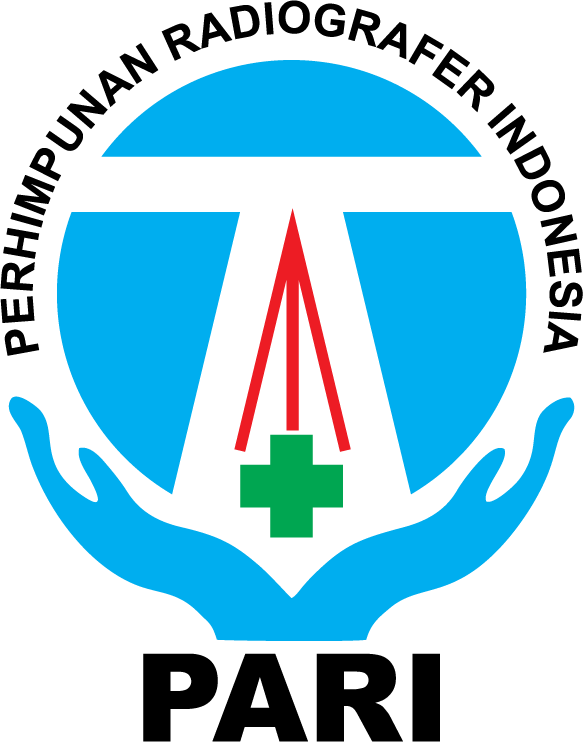Analisis Determinan Kesehatan Terhadap Kepatuhan Pemakaian Alat Pelindung Diri (Proteksi Radiasi) Bagi Radiografer di Wilayah Pasuruan Dan Sidoarjo
Abstract
Background: Hospitals in Pasuruan and Sidoarjo are Covid-19 referral hospitals that are very at risk of occupational infections for officers. Radiographer are workers who have more direct contact with patients, therefore nurses must apply the use of Personal Protective Equipment (APD) following the Standard Operating Procedure (SOP). The purpose of the study was to analyze the influence of health determinants (supervision, self-efficacy, and work culture) on compliance with the use of personal protective equipment (radiation protection) for radiographers in the Pasuruan and Sidoarjo regions.
Methods: Design observational research with a cross-sectional approach. The population of all radiographers in the Pasuruan and Sidoarjo is 100 people. Sampled all 100 radiographers with total sampling techniques. Independent variables of supervision, self-efficacy, and work culture. Variable dependent compliance with the use of personal protective equipment (radiation protection) for radiographers.
Results: The results showed there was an influence of radiographer surveillance patterns on compliance with the use of personal protective equipment (radiation protection) for radiographers (p-value 0.000), there was an effect of radiographer self-efficacy on compliance with the use of personal protective equipment (radiation protection) for radiographers (p-value 0.000), there was the influence of radiographer work culture on compliance with the use of personal protective equipment (radiation protection) for radiographers (p-value 0.000).
Conclusions: Supervision, self-efficacy, and work culture are among the factors that significantly influence radiographer adherence to the use of PPE. The hope is that by having a good knowledge of K3, nurses will be more obedient to protection as prevention of infection transmission.Keywords
Full Text:
PDFReferences
Akhadi M. (2012). Dasar-Dasar Proteksi Radiasi. Bineka Cipta.
Alavi, A., Bahrami, M., Zargham-Boroujeni, A., & Yousefy, A. (2015). Pediatric nurses’ perception of factors associated with caring self-efficacy: A qualitative content analysis. Iranian Journal of Nursing and Midwifery Research, 20(2), 232–238.
Arifin, A. B., & Susanto, A. (2013). Faktor-Faktor Yang Berhubungan Dengan Kepatuhan Pekerja Dalam Pemakaian Alat Pelindung Diri (APD) di Bagian Coal Yard Pt X Unit 3 & 4 Kabupaten Jepara Tahun 2012. Jurnal Kesehatan Masyarakat, 2(1).
BAPETEN. (2013). Peraturan Kepala Badan Pengawas Tenaga Nuklir Repulik Indonesia. Perka BAPETEN, 4 Thn 2013, 1–29.
Feist & J. Feist. (2014). Teori Kepribadian. Salemba Humanika.
Hendra, Y., Utomo, M., & Salawati, T. (2016). Beberapa Faktor Yang Berhubungan Dengan Praktik Pemakaian Alat Pelindung Diri (APD) Pada Radiografer Di Instalasi Radiologi 4 Rumah Sakit Di Kota Semarang.
Herwawan, Y. P., & Siagian, E. (2021). Faktor Yang Mempengaruhi Tenaga Kesehatan Dalam Upaya Pencegahan dan Pengendalian Pandemi COVID-19. Jurnal Penelitian Perawat Profesional, 3(4), 683–692.
Internasional Atomic Energy Agency. (2011). Radiation Protection and Safety Of Radiation Sources: Internasional Basic Safety Standards. IAEA.
Isnainy, U. C. A. S., Furqoni, P. D., Aryanti, L., & Asdi, L. S. (2019). Hubungan Beban Kerja, Budaya Kerja Dan Lama Kerja Terhadap Stres Kerja Perawat Di Ruang Irna Iii Rumah Sakit Umum Daerah Dr.H. Abdul Moeloek Provinsi Lampung. Manuju: Malahayati Nursing Journal, 1(1), 1–11.
Japeri, J., Helmi, Z. N., & Marlinae, L. (2016). Analisis Pengaruh Pengawasan, Pengetahuan Dan Ketersediaan Terhadap Kepatuhan Pemakaian Alat Pelindung Diri. Jurnal Berkala Kesehatan, 2(1), 41. https://doi.org/10.20527/jbk.v2i1.4845
Murhaini, S. (2014). Manajemen Pengawasan Pemerintahan Daerah (Edisi Regu). Pustaka Pelajar.
Nursalam. (2014). Manajemen Keperawatan Aplikasi dalam Praktik Keperawatan Profesional (4th ed.). Salemba Medika.
Prestiana, N. D. I., & Purbandini, D. (2016). Hubungan Antara Efikasi Diri (Self Efficacy) Dan Stres Kerja Dengan Kejenuhan Kerja (Burnout) Pada Perawat IGD dan ICU Rsud Kota Bekasi. Jurnal Soul, 5(2).
Pujiani, C. (2014). Analisis Budaya Kerja PT Bank Mandiri Tbk (Persero) Kanwil X Makassar. Universitas Hasanuddin Makassar.
Putri, J. M., & Rahayu, D. (2021). Analisis Faktor – Faktor Yang Berhubungan Dengan Perilaku Penggunaan Alat Pelindung Diri ( APD ) Pada Perawat Instalasi Gawar Darurat Di Rumah Sakit Di Kota Bandar Lampung Tahun 2018. Jurnal Ilmu Kesehatan Masyarakat Indonesia (JIKMI), 2(April).
Rismayanti, M., & Hardisman, H. (2019). Gambaran Pelaksanaan Program Pencegahan dan Pengendalian Infeksi Di Rumah Sakit Umum X Kota Y. Jurnal Kesehatan Andalas. https://doi.org/10.25077/jka.v8i1.989
Sudarmo, S., Helmi, Z. N., & Marlinae, L. (2017). Faktor Yang Mempengaruhi Perilaku Terhadap Kepatuhan Penggunaan Alat Pelindung Diri (Apd) Untuk Pencegahan Penyakit Akibat Kerja. Jurnal Berkala Kesehatan, 1(2), 88. https://doi.org/10.20527/jbk.v1i2.3155
Tubagus, D. A. (2013). Pentingnya Budaya Kerja Tinggi dan Kuat Absolute. Refika Aditama.
DOI: https://doi.org/10.31983/jimed.v8i1.8076
Article Metrics
Refbacks
- There are currently no refbacks.
JURNAL IMEJING DIAGNOSTIK by http://ejournal.poltekkes-smg.ac.id/ojs/index.php/jimed is licensed under a Creative Commons Attribution-ShareAlike 4.0 International License.

.png)
.png)
.png)
.png)
.png)
.png)
.png)











